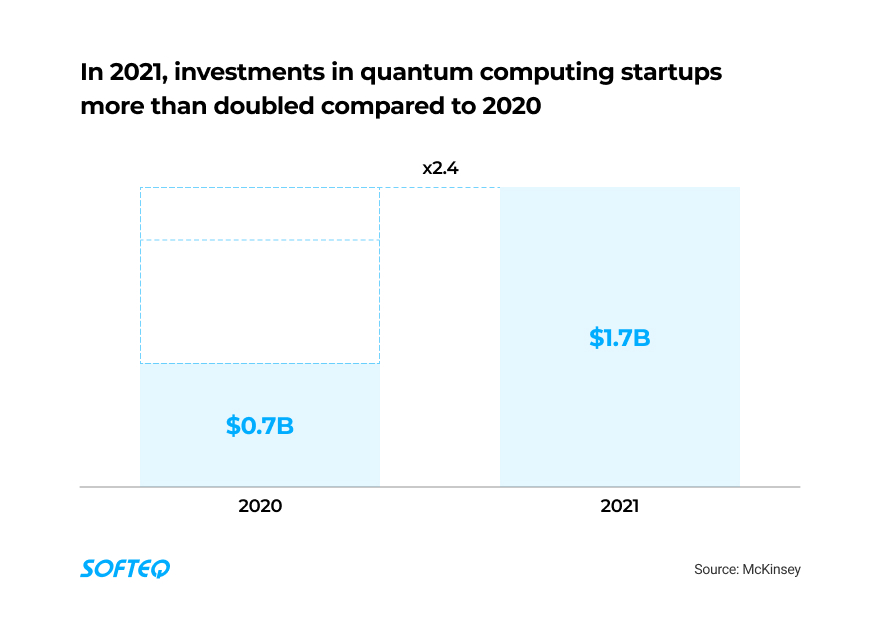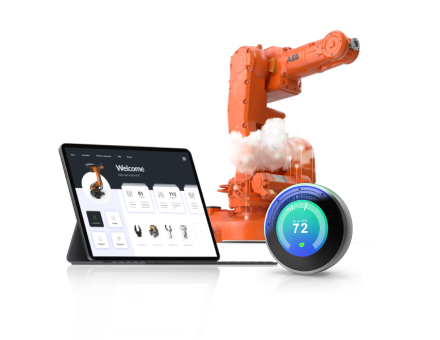Check out our latest blog article: From component to enterprise – modular robotics done right.
Quantum Computing Applications for Businesses

Over the last few years, businesses have been striving for digital transformation. Before, their goal was to capture as much data as possible. This helped in making data-driven decisions and planning for the future. Now it’s time to go further and use new tools, such as quantum computing applications.
So what data challenges do we have today? First, it’s data abundance and slow data processing. This remains a major problem in the car manufacturing industry. Second, it’s a lack of detail in data. For example, we don’t know the exact molecular structure of most enzymes in chemistry or pharmaceuticals. That’s why drug designers have to conduct more tests with more variables. This hinders fast drug design and development. These and other challenges can’t be solved with traditional computing.
Here comes quantum computing. It processes terabytes of data much faster and makes more precise predictions. For years, only researchers could explain what quantum computing is. It was a totally experimental segment in hardware and software development. But today, many consider quantum computing applications as the most likely tool to open up a new era in many industries. Let’s look at quantum computing explained with real-life examples.
What Is Quantum Computing?
Quantum computing is a technology that does quick calculations in complex problems where many variables interact in many ways simultaneously. Variables can be particles in a molecule, autonomous cars on roads, or vehicles in a global logistics network. Quantum computing allows us to model multiple possible scenarios with these variables.
This happens thanks to the following principle: Classic computers are programmed with bits (a one or zero) as data units. Quantum computing represents information in quantum bits or qubits. Each qubit can stand for an infinite number of states between one and zero.
Traditional computing looks like a light switch that’s either on or off. Quantum computing is more reminiscent of a dimmer, with a variety of possible states between on and off.
So do we now have a solution to complex problems with vast amounts of scenarios and possibilities? I hate to say it, but yes and no. Quantum computing lets us rethink our approach to unstructured data. Yet, it has not replaced conventional computing. Not today, and we don’t expect it to in the next few years. And here’s why.
Trends in the Quantum Computing Applications Market
To create a quantum computing-based application, you need three equally important elements. They are equipment, the cloud, and software. Here’s a problem already. From the standpoint of quantum computing, each of those elements is in its infancy and has a long way to go.
Hardware
Quantum computers outperform classic machines and supercomputers in speed. Yet, neither the US nor any other country has achieved a breakthrough in their mass production. A lack of powerful and affordable quantum computers is one of the main bottlenecks. No wonder investors focus most of their resources on this segment.
Cloud
Quantum computers are rare and expensive—few businesses can afford to own one. Quantum services via the cloud could be a solution. But current cloud platforms can hardly cope with avalanches of data processed at the highest speed. They would like to scale up in the right way, but how? Quantum computing technology is still experimental. There are no ready-to-use solutions for working with so much data at such a high speed.
That’s why the largest providers of cloud computing services are testing their capacities in symbiosis with hardware manufacturers. The cooperation looks like a win-win solution:
-
The cloud computing providers offer access to quantum computers on their platforms free of charge. This way, they can test the new technology in real-life conditions and add a new service to their portfolio.
-
Manufacturers can experiment with the technology without heavy investment in the infrastructure.
Software
Like any new technology, there needs to be time for quantum computing to be studied. Developers see that today, hardware and the cloud are not ready for large-scale use. So, they’re in no hurry to switch to this technology. A classic talent gap problem. Software development companies offer elements of quantum computing. But everyone is waiting for adequate hardware and cloud solutions.
Change may come as early as 2030, as several companies predict they will launch usable quantum systems by that time.
Quantum computing technology is not ready for full-scale commercial use cases. Most applications are still experimental. But as long as more money is poured in, the technology will develop quickly.

Let’s check the first use cases of quantum technologies.
Quantum Computing Application in Automotive
In modern automotive manufacturing, R&D’s share of investments is probably the largest. Millions are spent on the design and pre-testing of each vehicle element. And many components are routinely 3D-modeled for tests and simulations. However, 3D modeling is not the most reliable tool as it lacks accuracy. As a consequence, details are over-engineered or cost more than expected. This means the manufacturer has to restart the process, which potentially hampers commercial viability.
Quantum computers simulate component interactions within complex systems. They also take noise, vibration, extra loads, and other factors into account. In the end, their calculations are the most precise. Here’s how quantum computing can reduce costs and increase time-to-market:
-
It speeds up element design, simulation, and testing. You can apply it to as many factors as you want. The technology will consider each factor more precisely and quickly than traditional computing.
- It replaces costly physical prototypes with digital twins. A carmaker gets quick and precise calculations with any number of inputs and variables.
Real-life Example: Advanced Simulation of Chemical Reactions for EV Batteries
IonQ is a US quantum processor manufacturer. Back in 2019, the company performed its first simulations of a water molecule using quantum computing devices and algorithms. The tests demonstrated accurate chemical predictions. Since then, big research centers have been working with IonQ. Today, one of its investors and partners is Hyundai Motor Company.
These days, a battery is the most expensive component of an electric vehicle. The automotive giant wanted to build more effective batteries at a reduced cost. IonQ contributed to the project with quantum computing algorithms. Researchers used them to study and adjust the batteries’ charge and discharge cycles more precisely. Now, they also have better control of the chemical reactions involved in the process. As a result, Hyundai has more powerful, safe, and durable batteries.
Real-life Example: Cheaper Prototyping in Product Design for BMW
Physical prototyping is an expensive area of R&D. Automakers spend up to 30% of the total R&D expenditure to pre-test hardware components, assemble them, and test the final product.
This motivated BMW to contract a quantum computing technology developer, Pasqal. BMW wanted to learn how to apply the new technology to metal forming. With quantum computing in place, they now perform more virtual testing and have reduced the number of tests required. This has led to a 50% cost reduction in prototyping and testing.
Benefits
-
Doing more low-cost testing
-
More accurate component selection for automotive design
-
Replacing costly prototyping with its digital analog
Quantum Computing Application in Manufacturing
Some smart factories spend $500 billion per year on manufacturing costs. Even a 1% productivity gain would create billions in value per year, so manufacturers strive to make their work more effective. They upgrade legacy equipment, automate processes with robots, and add sensors and trackers everywhere. True, this already leads to certain cost reductions—but quantum computing may be a game-changer.

Quantum computing considers more factors than any other system and calculates all their combinations. This means it can come up with new, yet precise solutions.
Think about robots performing mundane functions like painting and gluing on the factory floor. To make their path planning efficient, a system needs to consider multiple criteria. A quantum-based application will evaluate all of them: stair slopes, the number of corners, external conditions, and so on. This would help a business plan paths better and shorten cycle times by seconds and even minutes.
Another example is maintenance and repair. When an accident occurs, it’s usually hard to define why it happened. Quantum computing calculates many possible scenarios to find the root cause. This way, a manufacturer knows why the problem emerged and how to mitigate such risks in the future.
Real-life Example: Detecting Errors in Manufacturing Processes
Chips are an Achilles’ heel in modern computer systems. Reports from Meta and Google show that failures in chips are hard to detect, yet, they can disrupt the whole network. The price of error is very high, so every chip maker wants to make their production 100% reliable.
The Canadian company, Solid State AI, develops quantum-based classic algorithms. They help chip makers identify what causes failures in their products. Their solution processes tons of data captured along the manufacturing line. It accurately predicts what could go wrong in the processes and how they should be corrected. This helps minimize faults in the chip’s structure and design at an early stage.
Benefits
- Timely corrections of work processes
- Dramatically reducing error rates in manufacturing
- Improving asset turnover
Quantum Computing Application in the Supply Chain
Logistics is getting more complex every day. Businesses work with thousands of delivery schedules, suppliers, and invoices. We have described how innovative logistics management technologies can optimize processes—but quantum computing does more than this. It has the capacity to integrate supply chains and their diverse elements in a single network. This puts an end to today’s siloes where planners schedule activities independently.
A traditional logistics app calculates a route from point A to point B and tries to figure out the most time and cost-efficient option. What can a quantum computing app do?
- It processes data from multiple systems simultaneously—transportation, inventory, schedule planners, and so on—to get a 360-degree view of the situation.
- It does multi-factor analysis and considers any number of criteria: fuel prices, time of delivery, environmental conditions, roadworks, etc.
- It makes quick simulations with changing parameters in “what-if” scenarios.
These operations are performed simultaneously and at a high speed.
Real-life Example: Building a Solution for Logistics Traffic Managers
Speedel is a UK B2B courier firm that works with aerospace and manufacturing companies. It uses hundreds of vehicles every day on multiple routes. This means billions of possible variants in route creation. A conventional computer can’t process so many shipment simulations, so the company decided to implement quantum computing.
They developed a practical app running on quantum algorithms. The app calculates all the possible options in planning and routing (yes, those billions mentioned earlier), does traffic simulations, and, finally, identifies the best option. For a fleet of hundreds of vehicles, this means huge time and money savings. Now, Speedel gets more shipments delivered in a shorter time frame.
Benefits
- Considers any number of factors and makes traffic simulations for financially-savvy routes
- Better traffic pattern prediction
- Optimizing workflows
Quantum Computing Application in Pharmaceuticals
Drug discovery is a costly process. Developing a single drug is commonly estimated to cost $2 billion. While one in 10 makes it to the market, the other attempts fail at one of the clinical development stages. Quantum computing in pharma could reduce these costs and may lead to cheaper drugs in the long run.
The technology allows researchers to:
- Model the necessary drug-target interactions. The technology helps compare how complex molecules may interact with each other in a future drug. Moreover, it does calculations even with compounds whose full formula is unknown. This helps predict positive and negative reactions in a situation of high uncertainty.
- Screen large virtual libraries. This way, a researcher can select the most relevant compounds much more efficiently and quickly.
- Reduce the need for expensive in vitro testing. Instead of working with samples like human blood or tissue, a pharma company can create virtual patients, i.e., an interactive computer simulation used to study drug reactions.
Real-life Example: Modeling and Simulating Interactions Between Drugs
The French company, Qubit Pharmaceuticals, uses quantum computing to model how molecules behave and interact. It’s a small research team without the resources of big pharma. However, in March 2022, they launched an ambitious program for designing novel COVID-19 treatments. What’s more, their algorithms helped discover the most suitable compounds in just six months.
Qubit Pharmaceuticals tested huge data libraries to find compounds that could help fight the virus. Their solution carried out simulations with drug candidates and modeled possible chemical reactions. In the end, they discovered two novel drug candidates and brought them to a further drug development stage. The research is ongoing. Over six months, the team has shown astonishing results, given the time and cost constraints.
Benefits
- Quickly screening data libraries of drug candidates
- Using quantum physics to run simulations for a vast number of variables
- A more cost-effective solution for conducting computations
Getting Technology Ready
That was a brief recap of what quantum computing is and how it can disrupt the world as we know it. At Softeq, we can’t wait to see when the technology gets mature enough for mass adoption. And of course, we acknowledge how dramatically it can enforce our own software and hardware development services. Our team will keep an eye on new developments in quantum computing applications.
More articles on the topic






